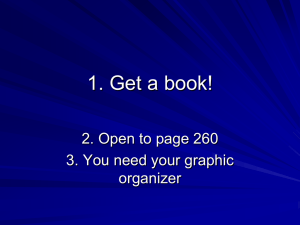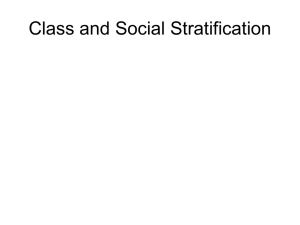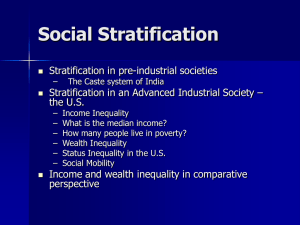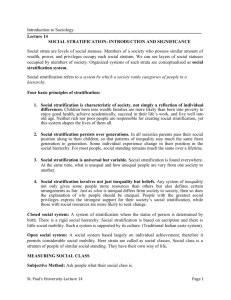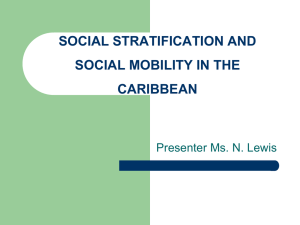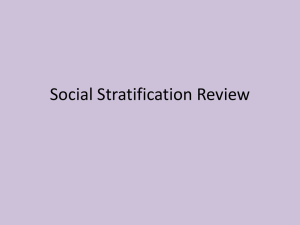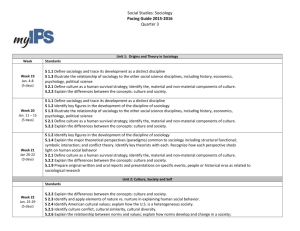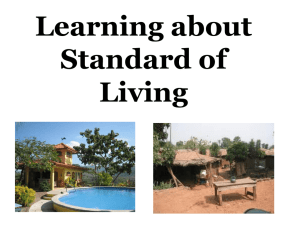Ch. 8 Stratification Notes
advertisement
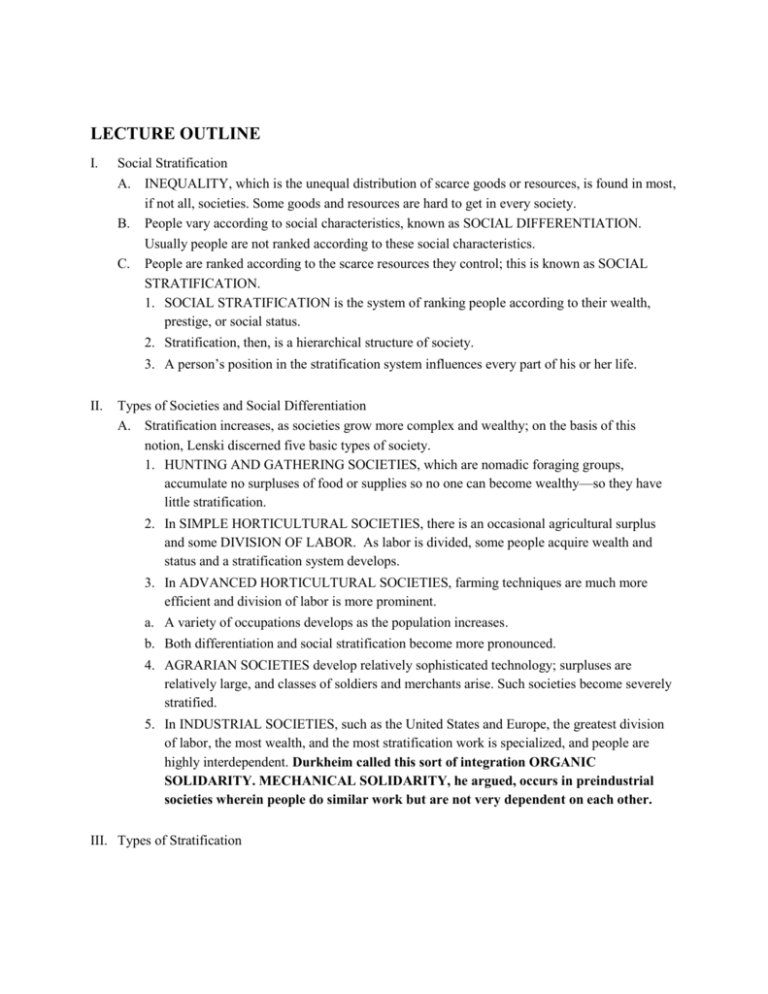
LECTURE OUTLINE I. Social Stratification A. INEQUALITY, which is the unequal distribution of scarce goods or resources, is found in most, if not all, societies. Some goods and resources are hard to get in every society. B. People vary according to social characteristics, known as SOCIAL DIFFERENTIATION. Usually people are not ranked according to these social characteristics. C. People are ranked according to the scarce resources they control; this is known as SOCIAL STRATIFICATION. 1. SOCIAL STRATIFICATION is the system of ranking people according to their wealth, prestige, or social status. 2. Stratification, then, is a hierarchical structure of society. 3. A person’s position in the stratification system influences every part of his or her life. II. Types of Societies and Social Differentiation A. Stratification increases, as societies grow more complex and wealthy; on the basis of this notion, Lenski discerned five basic types of society. 1. HUNTING AND GATHERING SOCIETIES, which are nomadic foraging groups, accumulate no surpluses of food or supplies so no one can become wealthy—so they have little stratification. 2. In SIMPLE HORTICULTURAL SOCIETIES, there is an occasional agricultural surplus and some DIVISION OF LABOR. As labor is divided, some people acquire wealth and status and a stratification system develops. 3. In ADVANCED HORTICULTURAL SOCIETIES, farming techniques are much more efficient and division of labor is more prominent. a. A variety of occupations develops as the population increases. b. Both differentiation and social stratification become more pronounced. 4. AGRARIAN SOCIETIES develop relatively sophisticated technology; surpluses are relatively large, and classes of soldiers and merchants arise. Such societies become severely stratified. 5. In INDUSTRIAL SOCIETIES, such as the United States and Europe, the greatest division of labor, the most wealth, and the most stratification work is specialized, and people are highly interdependent. Durkheim called this sort of integration ORGANIC SOLIDARITY. MECHANICAL SOLIDARITY, he argued, occurs in preindustrial societies wherein people do similar work but are not very dependent on each other. III. Types of Stratification A. There are two basic types of stratification systems. 1. In a CASTE SYSTEM, one’s caste is ascribed at birth and cannot be changed, although the caste as a whole can rise or fall in the social hierarchy. A caste system is a CLOSED SYSTEM because mobility between classes is impossible. 2. In a CLASS SYSTEM, anyone can move from class to class by gaining or losing wealth; since such movement is possible, class systems are considered OPEN SYSTEMS. IV. Sources of Power A. According to Weber, the scarce resources used to rank people are the sources of power in society. The three scarce resources that are sources of power are class, status, and party. B. SOCIAL CLASS is based on wealth, the power derived from wealth, and “life chances” to acquire wealth. LIFE CHANCES are the opportunities people have to improve their income. C. SOCIAL STATUS is the amount of honor and prestige a person receives from others in the community. 1. People who have status have power because they can influence those who respect them. 2. They can use this influence to increase their wealth. D. A PARTY is an organization in which decisions are made to reach the group’s goals. 1. Membership in a party can be used to enhance one’s social status. 2. Class, status and party are often closely interrelated. E. Because positions in a social hierarchy are influenced by many factors, it is difficult to determine a person’s precise position. 1. To assess status, sociologists have developed the concept of SOCIOECONOMIC STATUS (SES)—a measure of income, education, and occupation. 2. Usually, but not always, there is a consistent pattern among these three rankings of status. V. Theories of Social Stratification A. STRUCTURAL-FUNCTIONALISTS state that societies consist of interrelated parts, each of which serves a function in maintaining the society as a whole. 1. According to this view, societies must reward those who possess uncommon skills and perform important roles. 2. Those who make greater contributions to the functioning of society are more highly rewarded. 3. This perspective argues that if society had an equal need for all types of work, then all its members would be equal in the stratification system. B. CONFLICT theorists reject the functional viewpoint, arguing that inequality develops out of competition for power. 1. In this view, close-knit groups compete with one another to gain possession of the scarce resources that are a source of power. 2. Once a group attains dominance, it LEGITIMATES its power by appealing to the values of the masses. 3. These beliefs and perceptions when accepted by the masses become the prevailing IDEOLOGY, our ideas of society—how it should function and how it should be evaluated. 4. If the masses are influenced by elite ideology, they are said to have FALSE CONSCIOUSNESS, a lack of awareness of their own interests and an acceptance of elite rule. 5. If the masses are aware that people’s fates are tied to the fate of their whole class, they are said to have what is called CLASS CONSCIOUSNESS. 6. In summary, theories of social stratification are important not only for our own understanding but they provide a basis on which politicians and legislators develop social policies. C. Attempts at synthesis 1. Accumulating research suggests that stratification systems have a variety of causes; both the functional and conflict theories can contribute to our understanding of them. 2. It is widely accepted that all stratification systems are based on the consensus among members of society that inequality is good, fair, and just. 3. People may accept stratification because they value achievements of the wealthy or because the media has misled them. VI. Inequality in the United States A. The distribution of incomeroximately 1. In 2007, the median income in the United States for people with full-time jobs was app$32,000 per family of four. 2. In the United States during the decades of the 1990s and early 2000s, the rich did get richer and the poor got poorer (refer to Figures 8-1, 8-2, Tables 8-2, 8-3). This income distribution is similar to European countries’ distribution; but in European countries, tax and social programs distribute earnings much more equally than in the United States. B. The distribution of wealth 1. Wealth consists of personal property as well as income. 2. The thirteen thousand richest families in the U.S. now have almost as much income as the twenty million poorest. 3. More over, the wealthy actually CONTROL even more money than they POSSESS. 4. In comparing statistics of the wealthy with other countries, we see that the holdings of the wealthy are generally comparable to those of the United States. In England and in Ireland, the very wealthy hold an even greater share of their countries’ wealth than in the United States, while in Canada, the wealthy own a considerably smaller share than is the case in the United States. C. Social status in American society 1. Early studies on status in the United States indicated that status was conferred on others on the basis of their wealth. 2. A study of “Middletown” by the Lynds in the 1930s found substantial differences between the business class and the working class; a more recent study found it more difficult to identify classes among the population. D. Class consciousness 1. Jackman and Jackman (1983) found in a national study that most respondents defined themselves as belonging to one of five classes: poor (7.6 percent), working class (36.6 percent), middle class (43.3 percent), upper middle class (8.2 percent), and upper class (1 percent). 2. Members of the different classes are aware of others in their class and of their political interests. 3. However, most Americans believe that government should do nothing to create greater equality, even when government changes to tax policy cause greater inequality. 4. As a result, the rich continue to get richer and the poor get poorer. E. Poverty 1. The poverty line in 2002 was $18,390 for a nonfarm family of four. In 2001, 11.1 percent of the population, or 27.7 million people, were living in poverty. 2. Jobs for the poor would not solve the problem; of the adult poor, 40 percent work at jobs that pay so little that they fall below the poverty line. Only about 5 percent of poor people are adults who could be working but are not, and most of these do not work because they cannot find work (hard working poor janitor). 3. The level of poverty in the USA is generally higher than in other countries, particularly the proportion of children who are poor. VII. Inequality and Life Chances A. Occupations 1. For most people in the United States, the most important life chance is the opportunity to have a dignified job that provides an adequate income. Job opportunities vary with social class, however. 2. The majority of people in the U.S. are considered working class because they work in bluecollar jobs. 3. Many low-paid, working-class people fall below the poverty line and enter the class that has come to be called the “working poor.” B. Housing and lifestyle 1. The rich often own several homes; and members of the upper-middle class often have a house in the suburbs, as do some members of the working class, but are less apt to own their own homes. 2, The poor usually live in inadequate housing. The very poorest class lives in shelters or on the street. C. Education 1. The children of the rich and many middle-class families go to college, but few workingclass children get more than a high school education. Children from poor families tend to drop out of high school and often live in neighborhoods with poor schools, where they may not even learn to read and write. 2. Education is a life chance very closely associated with family wealth. D. Medical care 1. Medical care is not distributed equally. Most members of the upper and middle classes have health insurance, but the poor have trouble preventing illness and getting care when they are sick. 2. Some estimates are that one-third of Americans do not have health insurance and do not obtain the same medical care as the rich. 3. In the U.S., children have low rates of immunization for diseases compared to other nations. 4. In all modern industrialized societies except the United States and South Africa, everyone is covered by a national health system; children are immunized and adults are treated promptly, usually at no cost to the patient. E. Applying knowledge of inequality and life chances 1. Knowledge of class-related differences in life chances and of the consequences of inequality has wide spread implications. 2. Clinical sociologists and other therapists, as well as policy makers such as politicians and legislators, for teachers, and others must deal with these implications. VIII. Social Mobility in the United States Social mobility is movement from one position to another. It can be UPWARD or DOWNWARD, INTRAGENERATIONAL (a change in one’s class or status within a person’s own lifetime experiences) or INTERGENERATIONAL (wherein mobility is measured by comparing the social position of parents and children). A. Structural characteristics of mobility in the United States Mobility in the United States is influenced by numerous factors, some of which are listed below: 1. The growth of large corporations has made it possible for those who work in them to make relatively high wages. 2. The increasing standard of living has improved the lives of most American workers. 3. Since the cost of living is higher in cities, the growth of urban areas has led to higher wages for city dwellers. 4. The United States has a SPLIT LABOR MARKET in which some jobs lead to upward mobility and others do not. People such as women, the poor, and minority groups (rarely on career tracks) may have trouble improving their wages (last hired, first hired). 5. Advanced technology has eliminated some jobs involving manual labor and has increased the number of white-collar clerical and service jobs. B. Individual characteristics and upward mobility 1. One study showed that boys with ambitious attitudes had to change their attitudes when they could not reach their goals. 2. Other studies show that the factor that most accurately predicts men’s future income is family background. 3. Structural-functionalists believe that the best way to increase upward mobility is to increase the opportunities available to children from poor families. 4. Conflict theorists contend that opportunity and equality for the poor can only be brought about by changes in the stratification system and in the distribution of wealth.
